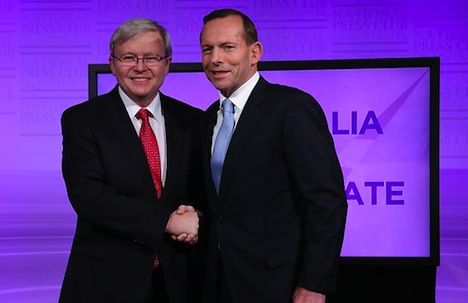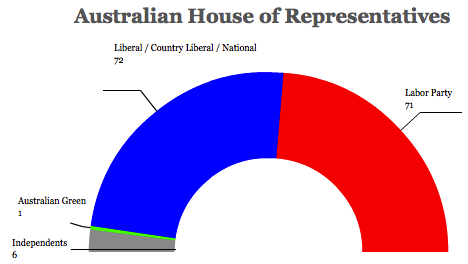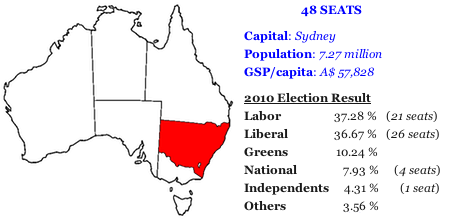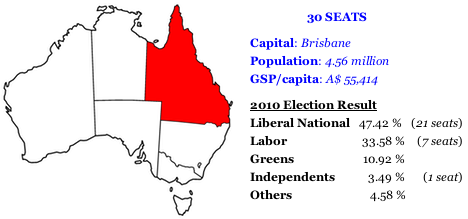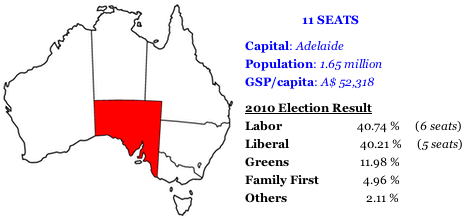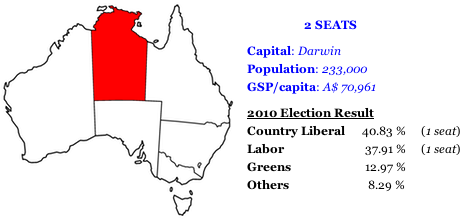Polls are now open across Australia, where voters will elect all 150 members of the House of Representatives, the lower house of the Australian parliament, and a little over half of the 75 members of the Senate, the upper house.![]()
If polling surveys prove correct, prime minister Kevin Rudd (pictured above, left) and the Australian Labor Party is facing certain defeat at the hands of Tony Abbott (pictured above, right), the leader of the Liberal Party and the center-right Coalition between the Liberals and Australia’s agrarian conservative National Party.
As we wait for results to come in later today, it’s worth taking a closer look at the voting to determine just what could happen.
Polls opened at 8 am and will close at 6 pm (for those of us on the east coast, polls close on Australia’s east coast at 7 am ET and on Australia’s west coast at 9 am ET). Voting is mandatory in Australia, with a fine of around A$20 for citizens who don’t participate.
Australia elects House members in single-member constituencies, but with a preferential voting system that ranks candidates (much like Ireland’s preferential vote). Each voter casts a ballot in one of 150 electoral districts throughout Australia. But instead of just voting for one candidate, voters rank their candidate to indicate preferences from first to last.
The so-called ‘primary vote’ is the tally of the first preferences of all voters. If, after the primary vote is counted, no candidate wins an absolute majority, the candidate with the lowest amount of support is eliminated, and the second preferences of the voters who preferred the eliminated candidate are distributed to the remaining candidates. Candidates are eliminated, and preference are allocated, until one candidate wins more than 50% of the vote. In reality, this typically means that all third-party candidates are eliminated, and the final count comes down to a contest between the Coalition and Labor — this is referred to as the ‘two-party preferred vote.’
So imagine a race with three candidate — Kevin, Tony and Christine. Suppose that in the primary vote, Kevin wins 35%, Tony wins 45% and Christine wins 20%. Christine would be eliminated, and we would look at the second preference of all of Christine’s voters. Suppose that Christine’s voters preferred Kevin and Tony equally — when the second-preference votes are added to the existing tallies, we would see that Tony wins the election with 55% to just 45% for Kevin.
The system for determining senators is even more complex because voters elect 12 senators for each state (in a typical election, voters select just six senators for each state, but in a ‘double dissolution’ election, voters sometimes choose all 12 at once). Senate elections are conducted with the same principles of preferred voting, but within statewide multi-member districts. I’ll spare you the details, but if you’re interested in how the vote count becomes exponentially more complex, feel free to watch this primer.
In the previous August 2010 election, neither Labor nor the Coalition won enough seats to form an absolute majority in the House — Abbott’s Coalition actually has one more MP in the House today than Rudd’s Labor (a 72-71), which means that Abbott needs to pick up just four seats to become prime minister:
Realistically, if polling data is correct, it’s not a question of whether Abbott and the Coalition will win — it’s a matter of how large Abbott’s majority will be. So without further ado, here’s a look at each of Australia’s six states and two territories and where Labor and the Coalition stands in each (for even further reading, here’s a look at the policies that Abbott’s government is likely to pursue and here’s an look at whether Labor MPs should have sacked former prime minister Julia Gillard three months ago in the hopes that Rudd could deliver an improbable victory.
New South Wales
New South Wales, Australia’s most populous state, holds nearly one-third of the seats in the entire House and almost two-thirds of the seats that Abbott needs to form a majority.
The good news for Rudd is that, according to Newspoll‘s final survey, NSW isn’t trending any worse for Labor than the rest of Australia. The bad news for Rudd is that means the Coalition leads 54% to 46% in the two-party preferred vote.
But if NSW is something of a bellwether for Australia (and it should be, given that it’s home to a third of Australia’s 22 million citizens), the writing for the Coalition’s impending victory was on the wall back in March 2011, when the Coalition returned to government in the state under leader Barry O’Farrell, winning 70 out of 93 seats in the NSW legislative assembly.
Labor MPs from New South Wales who are likely to survive Saturday include Justin Clare, the current minister for justice and home affairs; rising star Chris Bowen, a Rudd partisan who served as minister for immigration under Gillard and as treasurer since June 2013; and Anthony Albanese, a crucial Rudd ally and currently leader of the House, minister for infrastructure and transport and deputy leader and deputy prime minister since July 2013. All three should be considered future possible leadership contenders. Health minister Tanya Plibersek should also hold her seat of Sydney, and Rudd’s new immigration minister Tony Burke is favored to win as well.
Coalition MPs who will glide to reelection — and likely important government roles — include Philip Ruddock, shadow cabinet secretary and a former big beast of the Howard government as immigration minister from 1996 to 2003 and attorney general from 2003 to 2007, as well as Joe Hockey, a north Sydney MP who will likely become Australia’s next treasurer. Abbott will obviously win reelection from his Warringah seat northeast of Sydney, as will Malcolm Turnbull, Liberal leader from 2008 to 2009, who is a lock to hold his Wentworth seat east of Sydney.
So what seats should we watch from New South Wales as results pour in? Mostly marginal Labor seats that are likely to fall to the Coalition:
- In Sydney’s southwest suburbs, longtime Labor MP Daryl Melham (since 1990) hopes to hold on in the Banks district.
- To the northwest of Sydney, Michelle Rowland hopes to hold onto the Greenway seat she won in 2010 with just 50.88% of the vote.
- To the west of Sydney, Labor face three tough fights — Labor minister David Bradbury in Lindsey, MP Julie Owens in Parramatta and MP John Murphy in Reid.
- In Dobell, on the central coast north of Sydney, former Labor MP Craig Thomson is running for reelection despite the fact that he’s under investigation for using union money to pay for prostitutes — the race is a three-way contest among former cricket star and independent Nathan Bracken, Labor candidate Emma McBride and Liberal candidate Karen McNamara.
- In Bennelong, former Liberal prime minister John Howard’s seat from 1974 to 2007, Labor hopes to retake the seat that it won in 2007 and lost in 2010 to Liberal MP and former tennis champion John Alexander. But with Labor’s polling numbers, don’t hold your breath.
- Eden-Moreno, on the southeastern tip of NSW, is another toss-up between Labor MP Mike Kelly, minister for defence materiel, and Liberal challenger Peter Hendy.
Victoria
If there’s one place Labor hopes to stall the Coalition, it’s in Victoria, where the final Newspoll survey shows the Coalition with its narrowest lead, just 51% to Labor’s 49%.![]()
Though it’s long been a Labor stronghold, especially in Melbourne and its suburbs, the Liberal/National Coalition won the narrowest of victories over Labor in the 2010 state election and premier Denis Napthine is a narrow favorite to win reelection in next December’s state elections.
Labor MPs likely to win reelection from Victoria include Anna Burke, House speaker since October 2012; and Bill Shorten, minister for financial services and employment under Gillard. Shorten comes from the right wing of the Labor Party and he’s a frontrunner to become Labor’s next leader if Rudd loses the election.
Coalition MPs likely to win include Greg Hunt, shadow secretary for climate change; Kevin Andrews, shadow minister for families, housing and human services and a former minister in the Howard government from 2001 to 2007; and Andrew Robb, shadow minister for finance.
Nonetheless, Labor will be defending many seats today that were once safely within its ranks:
- In Batman (named for one of Melbourne’s founders, not the comic book hero), former resources minister Martin Ferguson has held the seat since 1996, but Labor’s David Feeney is battling to retain the seat.
- Corangamite in western Victoria, held by Warren Cheeseman since 2007, is a probably Coalition pickup.
- In Melbourne’s eastern suburbs, the Coalition hopes to pick off Deakin, where subsequent redistribution narrowed Mike Symon’s 2010 margin of victory to just 0.7%; and La Trobe, where Laura Smyth’s 2010 margin of victory was less than 2%.
- In Melbourne, Green MP Adam Bandt hopes to hold onto the seat he won in 2010 against Labor’s Cath Bowtell, despite the fact that he won’t have the strong second-preference votes of many Liberal voters this time around.
Queensland
Rudd’s return was supposed to bring his home state of Queensland back into play, with Rudd hopeful to make four or five Labor gains — and in July at the height of the honeymoon for the Rudd restoration, polls showed that Rudd might just do that.![]()
But the tables have turned precariously against Rudd, who might lose his own district of Griffith, just south of Brisbane, despite the fact that he’s been a member of the House since 1998. Liberal National challenger Bill Glasson, an ophthamologist and former president of the Australian Medical Association, is waging a fierce campaign, and Rudd could face the same ignoble fate as Howard did in 2007.
Moreover, Labor could now lose as many as six seats in Queensland, according to polls. The final Newspoll survey shows the Coalition leading Labor by a phenomenal 59% to 41% in the state.
The difference between July and September is the difference between a narrow Rudd majority and an Abbott landslide.
At the state level, Labor suffered a massive setback in March 2012 when Labor premier Anna Bligh was routed Queensland’s state elections after Labor won just seven seats, ending a consecutive 14-year tenure for Labor. The Liberal National Party won 78 out of 89 seats in the Legislative Assembly under leader Campbell Newman. (Unlike in other states where the Liberals and Nationals run in coalition, the two parties in Queensland formally merged in 2008.)
Peter Dutton, shadow minister for health and aging and a potential future Liberal Party leader, is projected to win his seat north of Brisbane.
Bob Katter, an agrarian independent with social conservative and economically leftist views, who holds a seat in Queensland’s far north, is also likely to be reelected. Warren Truss, the leader of the National Party nationwide, is also likely to be reelected to the seat he’s held for 30 years in northern Queensland as well.
- In Lilley north of Brisbane, former treasurer Wayne Swan — a fiercely loyal Gillard supporter — is fighting for political survival in one of the marquee contests of the 2013 election.
- Forde, a seat south of Brisbane, was a Liberal National pickup in 2010, when Bert Van Manen won the seat with just 3.26% of the two-party vote. But while Labor recruited Queensland’s relatively popular former premier Peter Beattie (1996 to 2007) to contest the race, the Liberal Nationals are nonetheless likely to retain the seat.
- In Capricornia on the central Queensland coast, Labor hopes to retain the seat of retiring MP Kirsten Livermore, who’s held the division since 1998, though the division swung by 8.4% to Liberal National challenger Michelle Landry in 2010 when she first fought for the seat.
- In Moreton, south of Brisbane, Labor MP Graham Perrett faces a toss-up race against Liberal National challenger Malcolm Cole. Yvette D’Ath, another Labor MP who was elected for the first time in 2007, faces an equally strong challenge north of Brisbane in the Petrie division.
- Among the seats that Rudd once hoped to steal from the Liberal Nationals, keep an eye on Bonner, a district east of Brisbane that’s changed hands in each of the last three elections, currently held by Liberal National MP Ross Vasta, as well as Brisbane, which Labor held for 30 years before Teresa Gambaro won the district in 2010.
- Though it’s essentially a sideshow, disgraced former speaker Peter Slipper is running for reelection as an independent candidate in Fisher on the Sunshine Coast north of Brisbane against both Liberal and Labor challengers. After resigning as speaker under a cloud of sexual harassment charges, it is unlikely that Slipper will win, although he’s held the seat for nearly three decades.
Western Australia
There’s relatively little drama in Western Australia because the Coalition already dominates Australia’s wealthiest state.![]()
Far from Canberra, the state is known for its conservative and anti-government tilt, and given the importance of mining to the state’s economy, Labor’s landmark mining ‘superprofits’ tax is not incredibly popular here. Unlike other states, the National Party competes separately from the Liberal Party in state elections and has a much more independent nature here, which sometimes even pits National and Liberal candidates against one another.
State elections in March 2013 were considered an early election-year setback for Gillard, though no one had particular expected Labor premier Colin Barnett to hold onto power.
Julie Bishop, who is widely tipped to become the next foreign secretary, is a lock to hold onto her seat in the wealthy oceanside suburbs east of Perth. Mark Butler, who was appointed minister for climate change by Rudd in June, is expected to be reelected and will likely play a key role in helping a defeated Labor rebuild itself.
The final Newspoll survey shows the Coalition with a 58% to 42% lead. As it already holds 12 out of 15 seats, there are few opportunities for additional pickups, but there’s one in particular that would be an especially sweet win for the Liberals:
- Brand, south of Perth, has been held by Gary Grey since 2007. Grey, a Gillard supporter, was a special minister of state until Rudd’s resurgence in June. Before his comeback, he served as Labor’s national secretary from 1993 to 1999, when the party suffered two electoral losses in 1996 and 1998 under former prime minister Paul Keating.
- Hasluck is Western Australia’s most marginal seat in the western suburbs of Perth, and Liberal MP Ken Wyatt won the seat in 2010 by just 1.14% in the two-party preference vote. If Wyatt, the first indigenous MP in the Australian parliament, doesn’t hold onto this seat, it may mean that Labor hasn’t suffered nearly the losses that everyone expects. (In that regard, keep an eye on the Swan district southeast of Perth, where Labor hopes to defeat incumbent Liberal MP Steven Irons).
- O’Connor is an only-in-Western-Australia kind of battle between Nationals and Liberals. The winner of the seat will sit with the Coalition no matter the outcome, but it’s still a fascinating race. National MP Tony Crook, the first National to win a seat in the state in three decades after defeating Liberal MP Wilson Tuckey in 2010, is retiring this year. That sets up a contest between the National candidate William ‘Chub’ Witham, a mining geologist and the Liberal candidate, farmer Rick Wilson. The division of Durack also features a similar National-Liberal contest. Although Labor backed Crook over the controversial Tuckey last time, Labor has endorsed the Liberal candidate as its preference in both seats.
South Australia
South Australia, unlike Western Australia and the Northern Territory, missed out on the mining boom that boosted incomes so much over the past two decades, and its top industries are retail, health care and manufacturing. With state elections due in March 2014, the 12-year Labor government is expected to lose a bid for a fourth consecutive term, bringing Liberal opposition leader Steven Marshall to power.![]()
Among the likely rising stars from South Australia is Christopher Pyne, who is currently shadow secretary for education.
The final Newspoll survey shows the Coalition with a 54% to 46% lead here, mirroring the national trend.
Which seats to watch? One in particular to keep an eye on:
- Makin, which includes northwestern Adelaide, is a bellwether district that has changed hands at both the 1996 Coalition wave and the 2007 Labor wave, which bodes ominously for Labor MP Tony Zappia — to the benefit of Liberal challenger Sue Lawrie.
Tasmania
The isolated pristine island state of Tasmania has leaned slightly to the left in past elections, but Labor could lose up to three of its four seats here.![]()
State elections are due here by May 2014, and the current Labor-Green coalition government is the latest iteration of 16 years of uninterrupted Labor rule. Accordingly, the government’s incredibly unpopular, amplifying Labor’s difficulty at the federal level:
- Bass, a marginal seat that often switches hands, has been represented by Geoff Lyons since 2010. He faces a strong challenge from decorated former brigadier Andrew Nikolić, a veteran of both Afghan and Iraqi wars, and the seat (like neighboring marginal Braddon) is almost certainly a Coalition pickup.
- Lyons, which covers much of the Tasmanian heartland, has been represented by Dick Lyons, an old-school Tasmanian union leader, since 1993. an incredibly marginal seat that often switches hands, has been represented by Geoff Lyons since 2010. If the Liberals take this seat, it will probably be an even better election than expected.
- Denison is shaping up to be a three-way race, with independent MP Andrew Wilkie trying to hold off Labor’s candidate, social worker and teacher Jane Austin. Wilkie won the seat in 2010 after rising to national prominence as the Richard Clarke of Australia — he’s a former intelligence agent who accused Australia’s intelligence agency of exaggerating the case for invading Iraq in 2003. After the 2010 election, Wilkie agreed to support Gillard’s government, but withdrew his support early in 2012 over Gillard’s failure to pass legislation mandating pre-commitment for poker machines (yes, really).
Australian Capital Territory
The Australian Capital Territory (or ACT) is the smallest of Australia’s states and territories., but it’s by far the most leftist state or territory in Australia.![]() Even as other local Labor governments fell during the Gillard era, Katy Gallagher led Labor to a fourth consecutive term in power after the territorial elections in October 2012 (she improved on Labor’s previous performance by 1.5%).
Even as other local Labor governments fell during the Gillard era, Katy Gallagher led Labor to a fourth consecutive term in power after the territorial elections in October 2012 (she improved on Labor’s previous performance by 1.5%).
If Labor loses either of its ACT-based seats, it will be a much wider loss for Rudd than even the worst-case scenarios are projecting.
Northern Territory
The Northern Territory, like Western Australia, has benefitted disproportionately from Australia’s resources boom over the past two decades, and that’s given it a conservative tilt. The center-right Country Liberal Party (CLP), while closely allied with the Liberal Party of Australia, is a unique territory-wide party that, among other things, advocates statehood for the Northern Territory. With the exception of a Labor administration from 2001 to 2012, the CLP has governed the Northern Territory since the establishment of the legislative assembly in 1974. Most recently, the CLP returned to power after winning the August 2012 territorial election.![]()
Indigenous issues are a big deal here — about one-third of the population is indigenous Australian and when Adam Giles became the CLP’s leader in March 2013, he became the first indigenous Australian to lead a state-level (or territory-level) government.
Labor and the CLP each hold one of the territory’s two House seats, and both could switch hands in the election:
- Solomon, which covers much of Darwin, represents one of Labor’s few possible pickups on Saturday, where Luke Gosling hopes to ride a more moderate, urban electoral to victory over the CLP’s incumbent MP Natasha Griggs.
- Lingiari, which covers the rest of the territory, has been represented by Warren Snowdon, a minor government minister, since 2001 (and Snowdon represented the Northern Territory in the House from 1987 to 1996 and again from 1998 to 2001.
